
《绩效管理(F5)》课程教学大纲 一、课程基本信息 课程代码:16033103 课程名称:绩效管理(F5) 英文名称:Performance Management 课程类别:专业课 时:48 学 分分:3 适用对象:国际会计(ACCA)创新实验区 老核方式:老试 先修课程:管理会计(F2 二、课程简介 《绩效管理(F5)》是ACCA全球统考科目之一。本课程主要介绍管理会计方法 的应用,主要内容包括:专家成本、决策制定、编制预算、标准成本法和差异分析、 业绩计量和控制等。通过本课程的学习,学生应当能够掌握管理会计方法在企业中的 应用,并能够分析不同方法对企业决策的影响。本课程有助于学生进一步掌握管理会 计知识方法体系,并理解管理会计在企业中的作用。 "Performance Management (F5)"is one of the ACCA global examination subjects This course mainly introduces the application of management accounting methods. including specialist cost,decision making.budgeting.standard cost and variance analysis performance measurement and control.etc..Through the study of this course.students should be able to master the application of management accounting methods in the enterprise,and can analyze the impact of different methods on enterprise decision-making. This course will help students to master the knowledge system of management accounting and understand the role of management accounting in enterprises. 三、课程性质与教学目的 课程性质:专业必修课(国际会计(ACCA)创新实验区) 教学目的:效率和公平是发展社会主义市场经济相辅相成,不可或缺的关系。掌 握管理会计知识和技能的应用,包括专家成本、决策制定、编制预算、标准成本法和 差异分析、业绩计量和控制
1 《绩效管理(F5)》课程教学大纲 一、课程基本信息 课程代码:16033103 课程名称:绩效管理(F5) 英文名称:Performance Management 课程类别:专业课 学 时:48 学 分:3 适用对象: 国际会计(ACCA)创新实验区 考核方式:考试 先修课程:管理会计(F2) 二、课程简介 《绩效管理(F5)》是 ACCA 全球统考科目之一。本课程主要介绍管理会计方法 的应用,主要内容包括:专家成本、决策制定、编制预算、标准成本法和差异分析、 业绩计量和控制等。通过本课程的学习,学生应当能够掌握管理会计方法在企业中的 应用,并能够分析不同方法对企业决策的影响。本课程有助于学生进一步掌握管理会 计知识方法体系,并理解管理会计在企业中的作用。 "Performance Management (F5)" is one of the ACCA global examination subjects. This course mainly introduces the application of management accounting methods, including specialist cost, decision making, budgeting, standard cost and variance analysis, performance measurement and control, etc.. Through the study of this course, students should be able to master the application of management accounting methods in the enterprise, and can analyze the impact of different methods on enterprise decision-making. This course will help students to master the knowledge system of management accounting, and understand the role of management accounting in enterprises. 三、课程性质与教学目的 课程性质:专业必修课(国际会计(ACCA)创新实验区) 教学目的:效率和公平是发展社会主义市场经济相辅相成,不可或缺的关系。掌 握管理会计知识和技能的应用,包括专家成本、决策制定、编制预算、标准成本法和 差异分析、业绩计量和控制
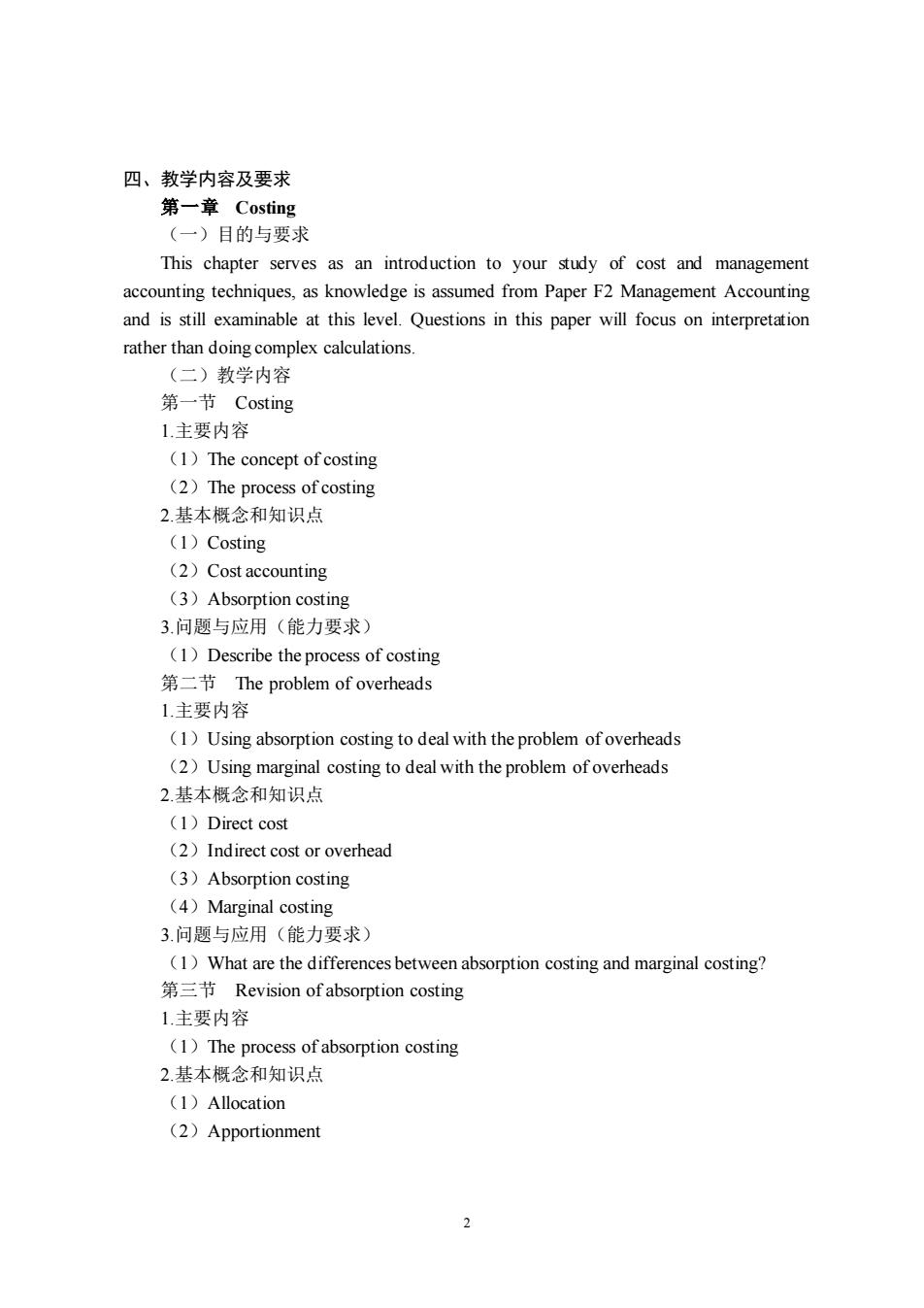
四、教学内容及要求 第一章Costing (一)目的与要求 This chapter serves as an introduction to your study of cost and management accounting techniques,as knowledge is assumed from Paper F2 Management Accounting and is still examinable at this level.Questions in this paper will focus on interpretation rather than doing complex calculations. (二)教学内容 第一节Costing 1主要内容 (1)The concept of costing (2)The process of costing 2.基本概念和知识点 (1)Costing (2)Cost accounting (3)Absorption costing 3问题与应用(能力要求) (1)Describe the process of costing 第二节The problem of overheads 1.主要内容 (1Using absorption costing to deal with the problem of overheads (2)Using marginal costing to deal with the problem of overheads 2.基本概念和知识点 (1)Direct cost (2)Indirect cost or overhead (3)Absorption costing (4)Marginal costing 3问顾与应用(能力要求】 (1)What are the differences between absorption costing and marginal costing? 第三节Revision ofabsorption costing 1主要内容 (1)The pro cess of absorption costing 2.基本概念和知识点 (1)Allocation (2)Apportionment
2 四、教学内容及要求 第一章 Costing (一)目的与要求 This chapter serves as an introduction to your study of cost and management accounting techniques, as knowledge is assumed from Paper F2 Management Accounting and is still examinable at this level. Questions in this paper will focus on interpretation rather than doing complex calculations. (二)教学内容 第一节 Costing 1.主要内容 (1)The concept of costing (2)The process of costing 2.基本概念和知识点 (1)Costing (2)Cost accounting (3)Absorption costing 3.问题与应用(能力要求) (1)Describe the process of costing 第二节 The problem of overheads 1.主要内容 (1)Using absorption costing to deal with the problem of overheads (2)Using marginal costing to deal with the problem of overheads 2.基本概念和知识点 (1)Direct cost (2)Indirect cost or overhead (3)Absorption costing (4)Marginal costing 3.问题与应用(能力要求) (1)What are the differences between absorption costing and marginal costing? 第三节 Revision of absorption costing 1.主要内容 (1)The process of absorption costing 2.基本概念和知识点 (1)Allocation (2)Apportionment

(3)Overhead absorption 3.问题与应用(能力要求) (1)Briefly discuss the factors which could affect the choice of the bases an organisation may use to apportion service department costs 第四节Overhead absorption 1主要内容 (1)Use ofapredetermined absorption rate (2)Choosing the appropriate absorption base (3)Over-and under-absorption of overheads (4)The reasons for under-/over-absorbed overhead 2基本概念和知识点 (1)Absorption rate (2)Over-absorption (3)Under-absorption 3.问题与应用(能力要求) (1)Ouestions in studytext (2Exercises in practice and revision kit. 第五节Marginal costing 1主要内容 (1)The process of marginal costing 2.基本概念和知识点 (1)Marginal cost (2)Contribution (3)Marginal costing 3.问题与应用(能力要求) (1)Questions in study text. (2Exercises in practice and revision kit 第六节Absorption costing and marginal costing compared 1主要内容 (1)Reconciling the profit figures given by the two methods (2)Reconciling profits (3)Marginal vs absorption costing:Reporting to management (4)Manipulating profits 2.基本概念和知识点 (1)Profit
3 (3)Overhead absorption 3.问题与应用(能力要求) (1)Briefly discuss the factors which could affect the choice of the bases an organisation may use to apportion service department costs. 第四节 Overhead absorption 1.主要内容 (1)Use of a predetermined absorption rate (2)Choosing the appropriate absorption base (3)Over- and under-absorption of overheads (4)The reasons for under-/over-absorbed overhead 2.基本概念和知识点 (1)Absorption rate (2)Over-absorption (3)Under-absorption 3.问题与应用(能力要求) (1)Questions in study text. (2)Exercises in practice and revision kit. 第五节 Marginal costing 1.主要内容 (1)The process of marginal costing 2.基本概念和知识点 (1)Marginal cost (2)Contribution (3)Marginal costing 3.问题与应用(能力要求) (1)Questions in study text. (2)Exercises in practice and revision kit. 第六节 Absorption costing and marginal costing compared 1.主要内容 (1)Reconciling the profit figures given by the two methods (2)Reconciling profits (3)Marginal vs absorption costing: Reporting to management (4)Manipulating profits 2.基本概念和知识点 (1)Profit
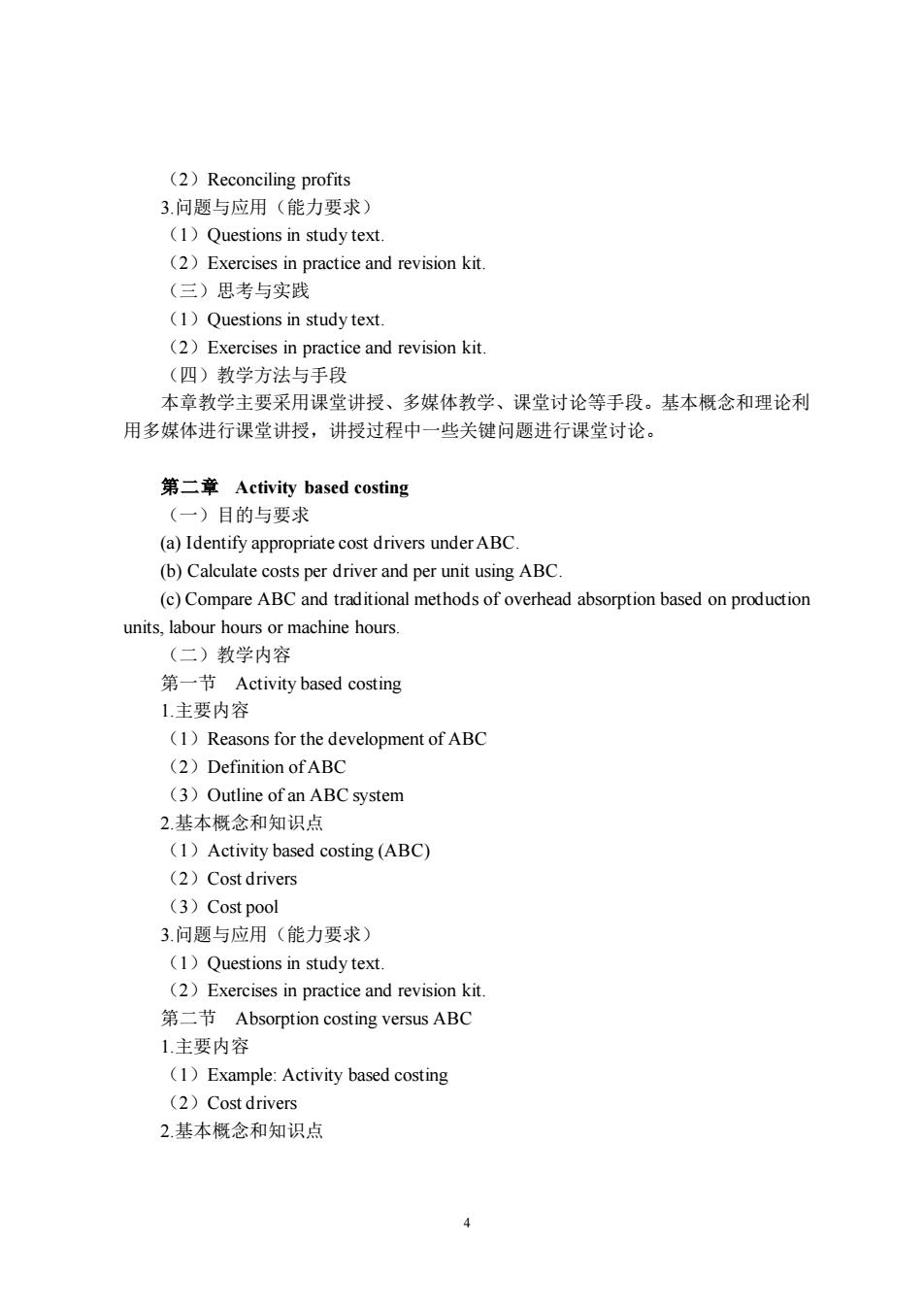
(2)Reconciling profits 3问题与应用(能力要求) (1)Ouestions in studytext (2)Exercises in practice and revision kit (三)思考与实我 (1)Questions in studytext. (2)Exercises in practice and revision kit. (四)教学方法与手段 本章教学主要采用课堂讲授、多媒体教学、课堂讨论等手段。基本概念和理论利 用多媒体进行课堂讲授,讲授过程中一些关键问题进行课堂讨论。 第二章Activity based costing (一)目的与要求 (a)Identify appropriate cost drivers under ABC. (b)Calculate costs per driver and per unit using ABC (c)Compare ABC and traditional methods of overhead absorption based on production units,labour hours or machine hours (二)教学内容 第-节Activity based costing 1.主要内容 (1)Reasons for the development of ABC (2)Definition ofABC (3)Outline of an ABC system 2.基本概念和知识点 (1)Activity based costing(ABC) (2)Cost drivers (3)Cost pool 3.问题与应用(能力要求) (1 Questions in study text (2)Exercises in practice and revision kit 第二节Absorption costing versus ABC 1主要内容 (1)Example:Activity based costing (2)Cost drivers 2基本概念和知识点
4 (2)Reconciling profits 3.问题与应用(能力要求) (1)Questions in study text. (2)Exercises in practice and revision kit. (三)思考与实践 (1)Questions in study text. (2)Exercises in practice and revision kit. (四)教学方法与手段 本章教学主要采用课堂讲授、多媒体教学、课堂讨论等手段。基本概念和理论利 用多媒体进行课堂讲授,讲授过程中一些关键问题进行课堂讨论。 第二章 Activity based costing (一)目的与要求 (a) Identify appropriate cost drivers under ABC. (b) Calculate costs per driver and per unit using ABC. (c) Compare ABC and traditional methods of overhead absorption based on production units, labour hours or machine hours. (二)教学内容 第一节 Activity based costing 1.主要内容 (1)Reasons for the development of ABC (2)Definition of ABC (3)Outline of an ABC system 2.基本概念和知识点 (1)Activity based costing (ABC) (2)Cost drivers (3)Cost pool 3.问题与应用(能力要求) (1)Questions in study text. (2)Exercises in practice and revision kit. 第二节 Absorption costing versus ABC 1.主要内容 (1)Example: Activity based costing (2)Cost drivers 2.基本概念和知识点

(1)Activity based costing(ABC) (2)Cost drivers (3)Cost pool 3.问题与应用(能力要求) (1)Questions in study text (2)Exercises in practice and revision kit 第三节Merits and criticisms of abc 1主要内容 (1)ABC and decision-makins (2)Criticisms ofABC 2基本概今和知识点 (1)Decision-making (2)Criticisms of ABC 3.问题与应用(能力要求) (1)Questions in study text (2)Exercises in practice and revision kit. (三)思考与实践 (1)Questions in study text. (2Exercises in practice and revision kit (四)教学方法与手段 本章教学主要采用课堂讲授、多媒体教学、课堂讨论等手段。基本概念和理论利 用多媒体进行课堂讲授,讲授过程中一些关键问题进行课堂讨论。 第三章Target costing (一)目的与要求 (a)Derive a target cost in manufacturing and service industries. (b)Explain the difficultiesof using target costing in service industries (c)Suggest how a target cost gap might be closed. (二)教学内容 第一节What is target costing? 1主要内容 (1)Describe target costing 2.基本概念和知识点 (1)Target costing (2)Target cost
5 (1)Activity based costing (ABC) (2)Cost drivers (3)Cost pool 3.问题与应用(能力要求) (1)Questions in study text. (2)Exercises in practice and revision kit. 第三节 Merits and criticisms of ABC 1.主要内容 (1)ABC and decision-making (2)Criticisms of ABC 2.基本概念和知识点 (1)Decision-making (2)Criticisms of ABC 3.问题与应用(能力要求) (1)Questions in study text. (2)Exercises in practice and revision kit. (三)思考与实践 (1)Questions in study text. (2)Exercises in practice and revision kit. (四)教学方法与手段 本章教学主要采用课堂讲授、多媒体教学、课堂讨论等手段。基本概念和理论利 用多媒体进行课堂讲授,讲授过程中一些关键问题进行课堂讨论。 第三章 Target costing (一)目的与要求 (a) Derive a target cost in manufacturing and service industries. (b) Explain the difficulties of using target costing in service industries. (c) Suggest how a target cost gap might be closed. (二)教学内容 第一节 What is target costing? 1.主要内容 (1)Describe target costing 2.基本概念和知识点 (1)Target costing (2)Target cost
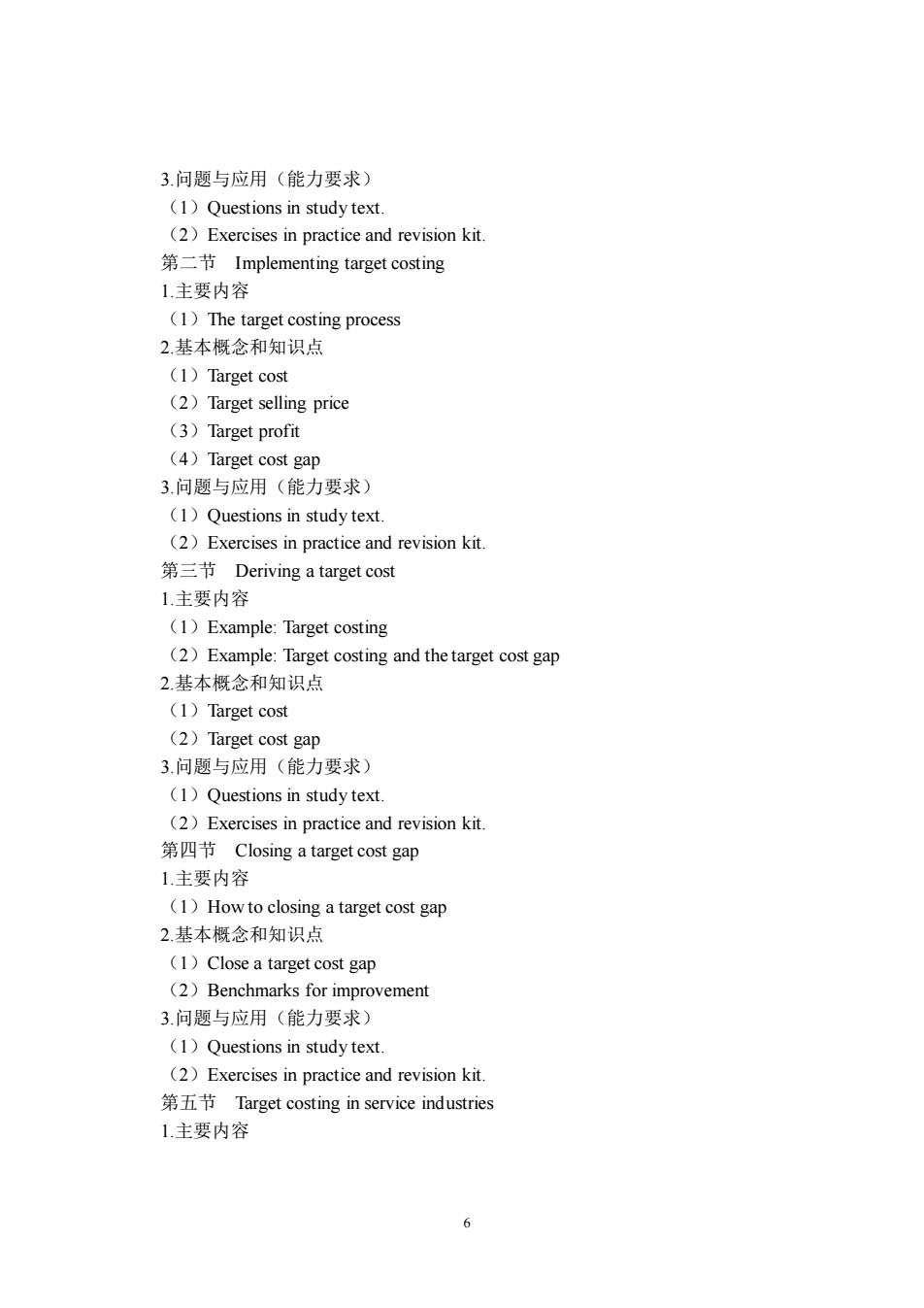
3.问题与应用(能力要求) (1)Questions in study text. (2)Exereises in practice and revision kit. 第二节Implementing target costing 1主要内容 (1)The target costing process 2.基本概念和知识点 (1)Target cost (2)Target selling price (3)Target profit (4)Target cost a即 3间题与应用(能力要求) (1)Questions in study tex (2)Exercises in practice and revision kit. 第三节Deriving a target cost 1主要内容 (1)Example:Target costing (2)Example:Target costing and the target cost gap 2.基本概念和知识点 (1)Target cost (2)Target cost gap 3.问题与应用(能力要求) (1)Questions in study text. (2)Exercises in practice and revision kit. 第四节Closing a target cost gap 1主要内容 (1)How to closing a target cost gap 2基本橱今和知识点 (1)Close a target cost gap (2)Benchmarks for improvement 3.问题与应用(能力要求) (1)Questions in study text (2)Exercises in practice and revision kit. 第五节Target costing in service industries 1主要内容
6 3.问题与应用(能力要求) (1)Questions in study text. (2)Exercises in practice and revision kit. 第二节 Implementing target costing 1.主要内容 (1)The target costing process 2.基本概念和知识点 (1)Target cost (2)Target selling price (3)Target profit (4)Target cost gap 3.问题与应用(能力要求) (1)Questions in study text. (2)Exercises in practice and revision kit. 第三节 Deriving a target cost 1.主要内容 (1)Example: Target costing (2)Example: Target costing and the target cost gap 2.基本概念和知识点 (1)Target cost (2)Target cost gap 3.问题与应用(能力要求) (1)Questions in study text. (2)Exercises in practice and revision kit. 第四节 Closing a target cost gap 1.主要内容 (1)How to closing a target cost gap 2.基本概念和知识点 (1)Close a target cost gap (2)Benchmarks for improvement 3.问题与应用(能力要求) (1)Questions in study text. (2)Exercises in practice and revision kit. 第五节 Target costing in service industries 1.主要内容
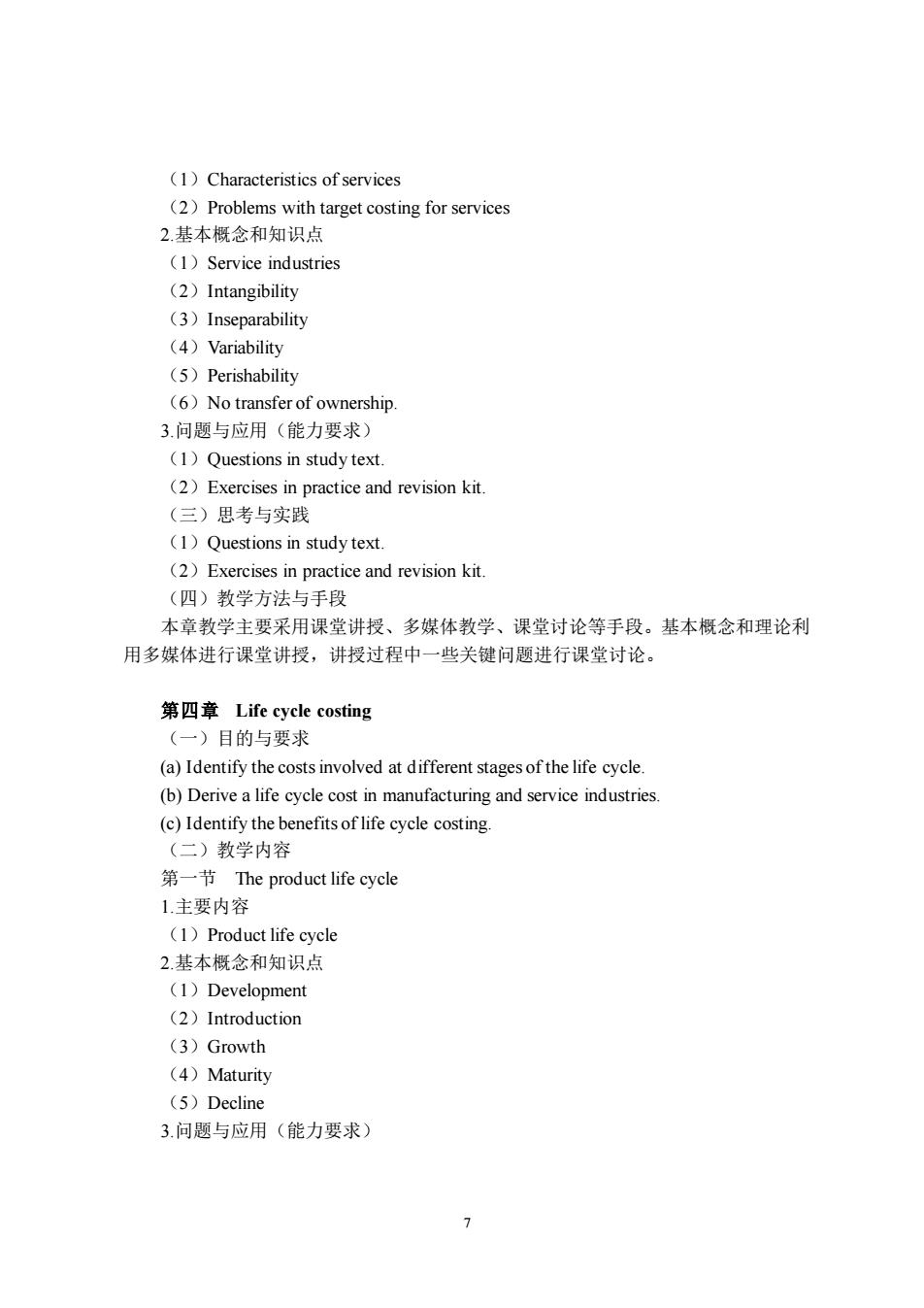
(1)Characteristics of services (2)Problems with target costing for services 2.基本概念和知识点 (1)Service industries (2)Intangibility (3)Inseparability (4)Variability (5)Perishability (6)No transfer of ownership 3.问题与应用(能力要求) (1)Questions in study text (2)Exercises in practice and revision kit. (三)思考与实践 (1 Questions in study text. (2Exercises in practice and revision kit (四)教学方法与手段 本章教学主要采用课堂讲授、多媒体教学、课堂讨论等手段。基本概念和理论利 用多媒体进行课堂讲授,讲授过程中一些关键问题进行课堂讨论。 第四章Life eyele costing (一)目的与要求 (a)Identify the costs involved at different stages of the life cycle. (b)Derive a life cycle cost in manufacturing and service industries (c)Identify the benefits of life cycle costing (二)教学内容 第一节The product life cycle 1主要内容 (1)Product life cycle 2基本概念和知识点 (1)Development (2)Introduction (3)Growth (4)Maturity (5)Decline 3.问题与应用(能力要求)
7 (1)Characteristics of services (2)Problems with target costing for services 2.基本概念和知识点 (1)Service industries (2)Intangibility (3)Inseparability (4)Variability (5)Perishability (6)No transfer of ownership. 3.问题与应用(能力要求) (1)Questions in study text. (2)Exercises in practice and revision kit. (三)思考与实践 (1)Questions in study text. (2)Exercises in practice and revision kit. (四)教学方法与手段 本章教学主要采用课堂讲授、多媒体教学、课堂讨论等手段。基本概念和理论利 用多媒体进行课堂讲授,讲授过程中一些关键问题进行课堂讨论。 第四章 Life cycle costing (一)目的与要求 (a) Identify the costs involved at different stages of the life cycle. (b) Derive a life cycle cost in manufacturing and service industries. (c) Identify the benefits of life cycle costing. (二)教学内容 第一节 The product life cycle 1.主要内容 (1)Product life cycle 2.基本概念和知识点 (1)Development (2)Introduction (3)Growth (4)Maturity (5)Decline 3.问题与应用(能力要求)
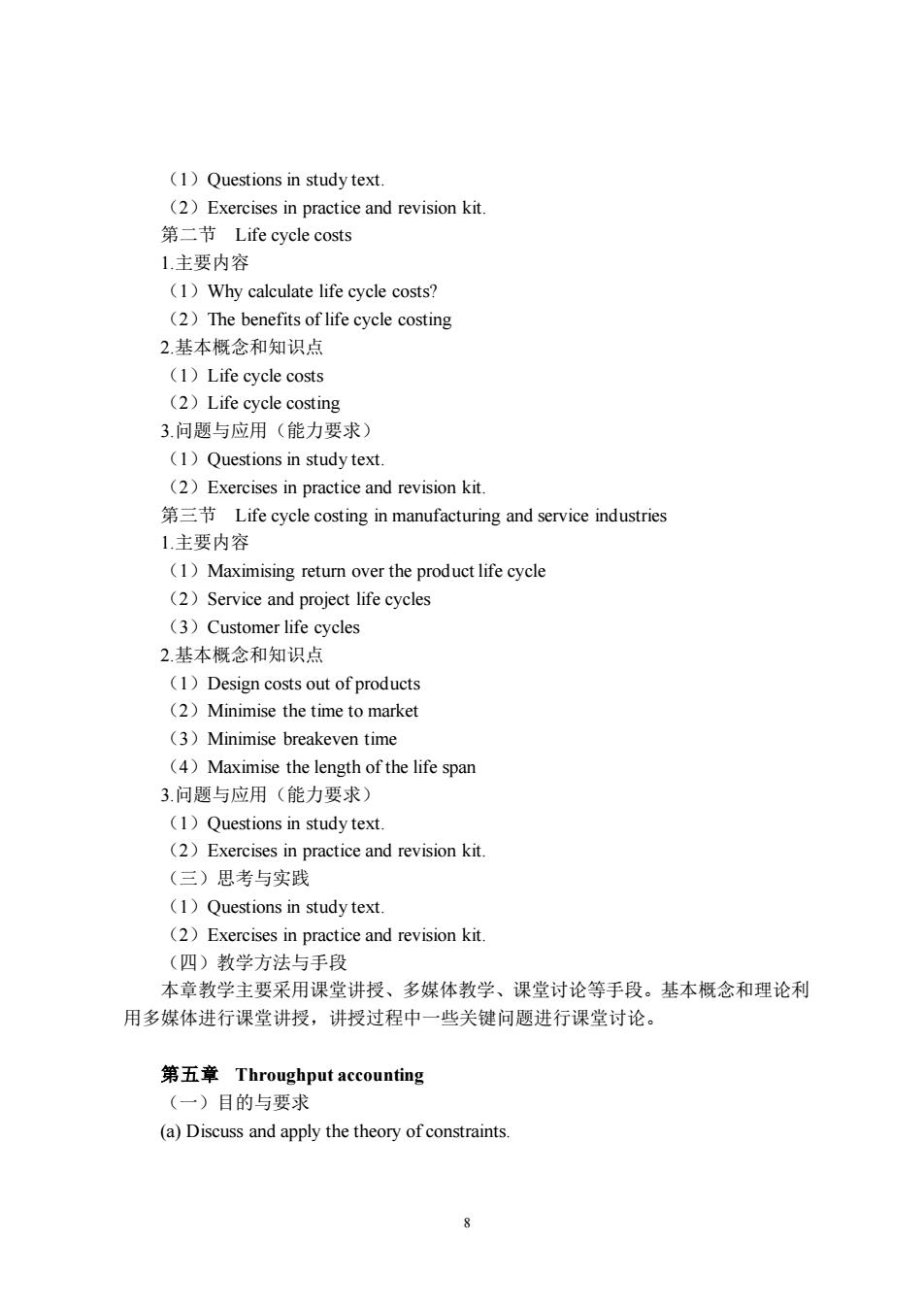
(1)Questions in study text. (2)Exercises in practice and revision kit. 第二节Life cycle costs 1.主要内容 (1)Why calculate life cycle costs? (2)The benefits of life cycle costing 2.基本概念和知识点 (1)Life cycle costs (2)Life cycle costing 3.问题与应用(能力要求) (1)Questions in study text (2)Exercises in practice and revision kit. 第三节Life cycle costing in manufacturing and service industries 1.主要内容 (1Maximising retum over the product life cycle (2)Service and project life cycles (3)Customer life cycles 2.基本概念和知识点 (1Design costs out of products (2)Minimise the time to market (3)Minimise breakeven time (4)Maximise the length of the life span 3.问题与应用(能力要求) (1)Questions in study text. (2)Exercises in practice and revision kit (三)思考与实践 (1)Questions in study text. (2)Exercises in practice and revision kit. (四)教学方法与手段 本章教学主要采用课堂讲授、多媒体教学、课堂讨论等手段。基本概念和理论利 用多媒体进行课堂讲授,讲授过程中一些关键问题进行课堂讨论。 第五章Throughput accounting (一)目的与要求 (a)Discuss and apply the theory of constraints
8 (1)Questions in study text. (2)Exercises in practice and revision kit. 第二节 Life cycle costs 1.主要内容 (1)Why calculate life cycle costs? (2)The benefits of life cycle costing 2.基本概念和知识点 (1)Life cycle costs (2)Life cycle costing 3.问题与应用(能力要求) (1)Questions in study text. (2)Exercises in practice and revision kit. 第三节 Life cycle costing in manufacturing and service industries 1.主要内容 (1)Maximising return over the product life cycle (2)Service and project life cycles (3)Customer life cycles 2.基本概念和知识点 (1)Design costs out of products (2)Minimise the time to market (3)Minimise breakeven time (4)Maximise the length of the life span 3.问题与应用(能力要求) (1)Questions in study text. (2)Exercises in practice and revision kit. (三)思考与实践 (1)Questions in study text. (2)Exercises in practice and revision kit. (四)教学方法与手段 本章教学主要采用课堂讲授、多媒体教学、课堂讨论等手段。基本概念和理论利 用多媒体进行课堂讲授,讲授过程中一些关键问题进行课堂讨论。 第五章 Throughput accounting (一)目的与要求 (a) Discuss and apply the theory of constraints

(b)Calculate and interpret a throughput accounting ratio(TPAR). (c)Suggest how a TPAR could be improved. (d)Apply throughput accounting to a multi-product decision-making problem. (二)教学内容 第一节Theory of constraints 1主要内容 (1)Throughput:sales,inventory and operational expenses (2)Bottleneck factor:the constraint (3)Production scheduling and the bottleneck resource (4)Increasing throughput:elevating the bottleneck (5)Example:elevating the constraint (6)Theory of constraints:summary (7)Example:An illustration of the theory of constraints 2.基本概念和知识点 (1)Theory of constraints(TOC) (2)Throughput (3Bottleneck resource or binding constrain 3.问题与应用(能力要求) (1)Questions in study text (2)Exercises in practice and revision kit. 第二节Throughput accounting 1主要内容 (1)Throughput accounting (TA) (2)Throughput accounting in a service industry 2.基本概念和知识点 (1)Throughput accounting(TA) (2JIT production 3.问题与应用(能力要求) (1)Questions in study text. (2)Exercises in practice and revision kit. s第三节Performance measures in throughput accounting 1.主要内容 (1)Example:Maximising throughput and multiple products (2)Throughput accounting and limiting factor analysis compared 2.基本概念和知识点
9 (b) Calculate and interpret a throughput accounting ratio (TPAR). (c) Suggest how a TPAR could be improved. (d) Apply throughput accounting to a multi-product decision-making problem. (二)教学内容 第一节 Theory of constraints 1.主要内容 (1)Throughput: sales, inventory and operational expenses (2)Bottleneck factor: the constraint (3)Production scheduling and the bottleneck resource (4)Increasing throughput: elevating the bottleneck (5)Example: elevating the constraint (6)Theory of constraints: summary (7)Example: An illustration of the theory of constraints 2.基本概念和知识点 (1)Theory of constraints (TOC) (2)Throughput (3)Bottleneck resource or binding constraint 3.问题与应用(能力要求) (1)Questions in study text. (2)Exercises in practice and revision kit. 第二节 Throughput accounting 1.主要内容 (1)Throughput accounting (TA) (2)Throughput accounting in a service industry 2.基本概念和知识点 (1)Throughput accounting (TA) (2)JIT production 3.问题与应用(能力要求) (1)Questions in study text. (2)Exercises in practice and revision kit. 第三节 Performance measures in throughput accounting 1.主要内容 (1)Example: Maximising throughput and multiple products (2)Throughput accounting and limiting factor analysis compared 2.基本概念和知识点

(1)Performance measures (2)Multiple products (3)Limiting factor analysis 3问题与应用(能力要求) (1)Questions in study text (2)Exercises in practice and revision kit. 第四节Throughput accounting ratio 1主要内容 (1)Interpreting the TA ratio (2)Example:TA ratios and ranking products (3)How can a business improve a throughput accounting ratio? (4)Throughput and limiting factor analysis 2.基本概念和知识点 (1)Throughput accounting ratio (TA ratio) (2)Ranking products 3.问题与应用(能力要求) (1)Questions in study text (2)Exercises in practice and revision kit. (三)思考与实践 (1)Questions in study text. (2)Exercises in practice and revision kit (四)教学方法与手段 本章教学主要采用课堂讲授、多媒体教学、课堂讨论等手段。基本概念和理论利 用多媒体进行课堂讲授,讲授过程中一些关键问题进行课堂讨论。 第六章Environmental accounting (一)目的与要求 (a)Environmental cost pays attention to environmental regulation and environmental cost,which is conducive to building a beautiful China. (b)Discuss the issues businesses face in the management of environmental costs. (c)Describe the different methods a business may use to account for its environmental costs (二)教学内容 第-节Managing environmental cost 1主要内容 10
10 (1)Performance measures (2)Multiple products (3)Limiting factor analysis 3.问题与应用(能力要求) (1)Questions in study text. (2)Exercises in practice and revision kit. 第四节 Throughput accounting ratio 1.主要内容 (1)Interpreting the TA ratio (2)Example: TA ratios and ranking products (3)How can a business improve a throughput accounting ratio? (4)Throughput and limiting factor analysis 2.基本概念和知识点 (1)Throughput accounting ratio (TA ratio) (2)Ranking products 3.问题与应用(能力要求) (1)Questions in study text. (2)Exercises in practice and revision kit. (三)思考与实践 (1)Questions in study text. (2)Exercises in practice and revision kit. (四)教学方法与手段 本章教学主要采用课堂讲授、多媒体教学、课堂讨论等手段。基本概念和理论利 用多媒体进行课堂讲授,讲授过程中一些关键问题进行课堂讨论。 第六章 Environmental accounting (一)目的与要求 (a) Environmental cost pays attention to environmental regulation and environmental cost, which is conducive to building a beautiful China. (b) Discuss the issues businesses face in the management of environmental costs. (c) Describe the different methods a business may use to account for its environmental costs (二)教学内容 第一节 Managing environmental costs 1.主要内容